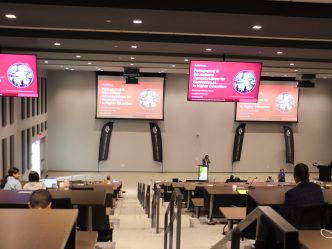To become successful at something takes practice and even studying people who have already successfully completed that action. Sometimes, it can also take inspiration from an unlikely source.
Dr. Ban Majeed, assistant professor of epidemiology in the Department of Population Health Sciences of the Medical College of Georgia at Augusta University, recently received a National Institutes of Health award for $203,773 to fund her research project, “Effect of tobacco use patterns on toxicant exposure and successful cessation: a longitudinal study among US adult cigarette smokers.”
The word Majeed was adamant be in that title is “successful.”
“The reason I fell in love with the title for the grant is because I wanted to focus on successful cessation. I wanted the word ‘success’ there,” Majeed said.
“We need to understand if someone succeeded in something, what did they do? Let us learn from successful examples and then maybe say, ‘OK, so, if your characteristics are not different from my characteristics, it means I can do what you’ve done.’ And if your characteristics are different — modifiable variables, we call them in research — if you’ve done something different than the person who relapsed, maybe I can encourage the person who may relapse to do that, to push them to be successful. So, I want to look at determinants of success.”
On top of receiving the funding for her research, Majeed has also been invited to speak at the Tobacco Treatment Specialist Training Recertification Conference taking place Florida. It’s an invitation that she knows is an honor, showing that her insight is valued.
Defining the parameters of the study
When it comes to smoking cessation, what does success look like? Before Majeed was able to outline her study and submit it to secure the funding, she had to define what successful cessation looks like.
“As a researcher, how do you define success? We decided there are different definitions,” Majeed said. “One definition is kind of the strict definition of success: if you’ve quit for three months, therefore, you’re more likely to stick with it for a year or more and less likely to relapse.
“So, three months is successful, but what if you have quit for less than three months?” Majeed continued. “We don’t want to call you an unsuccessful former smoker. So, we assigned that short term. So now we have parameters for successful abstinence, short-term abstinence and long-term abstinence.”
Even with the parameters for successful abstinence laid out, there was still another hurdle. Today, there are far more tobacco products on the market than 20 years ago, so becoming completely tobacco- or nicotine-free is harder to gauge, especially when people can mix and match the types of products they use.
“With all these combinations available today, we really don’t know if the person is getting more toxins, the same amount of toxins, or fewer toxins as if you’re only smoking traditional cigarettes,” Majeed said.
“The other big question is if a person wants to quit cigarettes but they still smoke hookah during the weekend, are they tobacco-free? Are they nicotine-free? What if a person uses e-cigarettes but they have stopped using combustible cigarettes? Where would I put that person in relations to successful smoking cessation, and how much toxins are actually in the body? The patterns of use complicate the picture.”
Getting approval for funding the study
It took three attempts for Majeed to successfully outline her study and show supporting data for the NIH to award her the funding. To receive funding, the study’s parameters have to be specific, and researchers have to show that they can be successful, including surrounding themselves with a strong team and support staff.
One of the key parts of Majeed’s team is Dr. Daniel Linder, assistant professor in the Division of Biostatistics and Data Science in the Department of Population Health Sciences within the MCG.
“I knew what I wanted to look at for the study and I figured out where I fit, but you need to be able to show the data you are going to pull from and you need the support of a team. I think in the beginning I couldn’t really convince the reviewers with what I submitted,” Majeed said.
“They gave me feedback, so I improved the application. During that time, we were able to have an article published as a glimpse of what we planned to do, and that helped to earn their trust. I’m in the beginning of the road and I’m very happy that this will be the first of many other funded grants years to come.”
The article that helped Majeed secure the funding was “Cluster Analysis of Urinary Tobacco Biomarkers among U.S. Adults: Population Assessment of Tobacco and Health (PATH) Biomarker Study (2013-2014),” which was published in the scientific journal Preventive Medicine in November 2020.
The study itself
According to the project summary for Majeed’s study, “Combustible cigarette smoking is the leading cause of preventable death and disease in the U.S. Each year, more than 400,000 Americans die due to reasons related to tobacco use. Strong scientific evidence exists linking smoking to elevated risk of pulmonary diseases, cardiovascular diseases (e.g. heart attack, heart failure, and stroke), and multiple types of cancer (e.g. of the oral cavity, lung, esophagus, kidney, uterus, and bone marrow).”
The summary goes on to outline the background of Majeed’s study, how the FDA regulates tobacco products, how new products have entered the market. The study also notes how patterns can be studied to help people learn to successfully quit smoking and better help the FDA in setting parameters for marketing materials on tobacco products.
“Resultant data could be leveraged to inform product labeling and public health campaigns, especially those addressing toxicant exposure and dependence risk of dual/poly product use,” the summary continues. “Until consumers are fully informed about the risks they take when engaging in dual/poly tobacco product use, we can expect more and more of them to engage in this potentially hazardous behavior.”
Majeed and Linder will not have to gather new data for their study, as they already have access to the data points, which also helped in publishing their study in 2020. The hardest part will be setting formulas to be able to analyze the data and sort it so Majeed can properly study it.

Drawing inspiration from an unlikely source
Majeed isn’t just passionate about her studies on tobacco and smoking cessation. She loves to paint and admires the works of the late, great painter and television personality Bob Ross.
“If you have watched any of Ross’s episodes, you know how calming he can be and there are many people I have read about that used to write him letters saying, ‘I have chronic pain and the only time I am calm is when I’m watching you,’” Majeed said.
“It’s empowering to people to tell them that they can produce this masterpiece, saying, ‘You can do it, too!’ You can draw that beauty out of the person, and imagine if you are a smoker, going through that difficult time and someone would look at you and not label you as smoker. That’s not who you are. That’s not your identity.”
It is this love of painting and surrounding oneself in beauty that inspires Majeed’s dream to one day have her own program that will actively help people break free from tobacco addiction.
“I have a dream and I can even picture how it’s going to look as far as the name for it,” Majeed said. “I want to incorporate art in tobacco treatment because we need to surround ourselves with beauty because the ugliness is everywhere.”
Wrapping up another study
On top of her own research, Majeed recently collaborated with Drs. David Walsh, Christos Hatzigeorgiou, Deepak Ayyala and a team of students from MCG on a study titled “Trends of hospitalization and case fatality rates in lab-confirmed COVID-19 adult patients at large academic medical center in Georgia, USA, March-December 2020” that they will submit for publication this year.
The study covered 18,000+ lab-confirmed COVID-19 cases in adult patients at Augusta University, and with the data, the team was able to determine the rates of hospitalization and fatality.
The summary of the study concluded that the hospitalization rate was higher in males compared to females, ages 45-64 and 65+ compared to ages 18-44, and in Black people compared to white people. Fatalities were higher in those 65 and older.
“I am excited about this study. Not because it is focused on a current pandemic, but because it applies the basic, most fundamental principles of epidemiology: describe data and identify patterns. Epidemiology is the study of disease distribution in a particular population. The main premise here is that disease is not randomly distributed in the population, which means there is a pattern for this distribution and that is what we aimed to describe in this study.”
Majeed’s background
Majeed is the course director and instructor of STAT6300 “Introduction to Epidemiology and Biostatistics” and STAT7130/EPID7130 “Introduction to Epidemiology,” two online foundational courses offered each year to students in nursing, physician assistance and other allied health and graduate programs, such as the Master of Public Health and the new Master of Science in Epidemiology.
In addition, Majeed facilitates Case-Based Learning, a small group discussion among medical students designed to promote skills of communication, collaboration, use of medical knowledge in patient care and the art of critical thinking.
Majeed began her career as a doctor in her home country of Iraq before transitioning into public health. She then earned her MPH in health promotion and behavioral sciences from Georgia State University in 2008, followed by her PhD in epidemiology, also from Georgia State, in 2015. She worked for several years at the Centers for Disease Control in Atlanta before coming to Augusta University.
 Augusta University
Augusta University




